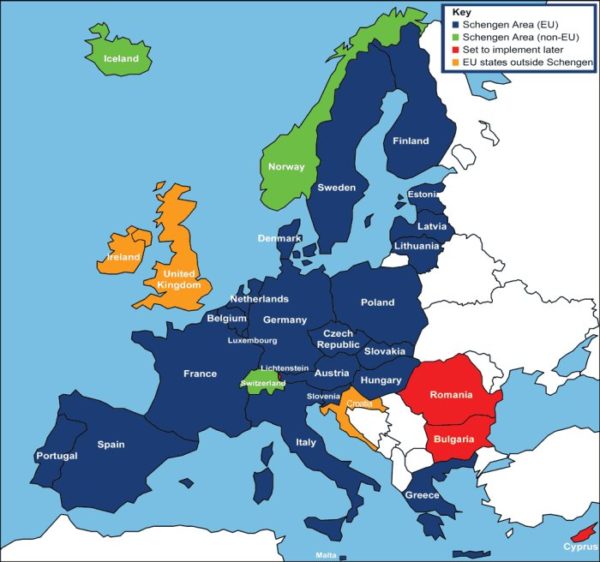Today, I am going to answer two important questions you might have about Romania: is Romanian part of the EU (European Union)? Also, is Romania part of the Schengen zone?
While these two questions refer to two different things, many people believe that if a country is a a member of the European Union, it already is part of the Schengen zone, and vice-versa – if it’s not part of the EU, it’s not in Schengen. Well… that’s not the case!
This is especially useful for those who like to travel around Europe and respect the Schengen travel rules (you are allowed to stay 90 days within a 180-day period) or better plan their itineraries if they only have a visa for Romania or the Schengen area.
Is Romania in the European Union?

Yes, Romania has been a member of the European Union since 2007, when it joined together with neighboring Bulgaria.
The two countries are among the newest members of the EU. Croatia is the only country that joined afterward, in 2013.
But even though Romania is a member of the European Union, it has still not switched to using the EURO, which is always delayed to “a later date” – so nothing is set in stone and probably it will be years before it will happen.
In other words, if you are planning to visit the country, prepare to visit an exchange office first and get some Romanian Lei – the country’s national currency, as it would be difficult to pay with anything else, even though Romania is indeed an EU member.
Or use one of the more modern approaches to banking – like getting a Wise card or Revolut or anything similar to instantly switch between currencies.
Is Romania in the Schengen area?
Unfortunately, Romania is still not a full member of the Schengen area. The country was very close to being allowed into the Schengen area, but Austria vetoed the decision in early December 2022, even though all other member states voted for Romanian joining.
However, since March 31st 2024, Romania was partially allowed into Schengen, together with Bulgaria.
In a first for the Schengen area, it means that there will no longer be checks on persons at EU internal air and maritime borders between Romania and other countries in the Schengen area.
So if you’re getting to Romania by plane from a Schengen country, or flying to another Schengen member from Romania (or by ship – only from the Constanta port), there should be no border checks anymore.
I say “there should” because, in these early days, I’ve seen plenty of reports online that Romanian passengers are still checked “randomly” by various countries. I am sure this will disappear in the next few months though.
But if you enter Romania by car, bus or train (or other land means), you will still need to show your passport, there will be a border check and potentially a Visa check too if you need it.
But at least things appear to be moving in the right direction and it is expected that Romania will fully join Schengen (with land borders too) by the end of the year.
When might Romania join the Schengen area?

Following the denial in December 2022, the chances of Romania entering the Schengen space in the very near future are minimal.
However, based on discussions I have heard on TV from officials and authorities, it seems that there are still hopes that the country will join the area by the end of 2024, or sometime in 2025.
So not very far ahead into the future, but also there’s no guarantee that things will be much different. However, all in all, everybody feels and knows that Romania is closer than ever to being a Schengen member.
Why does it matter if Romania a Schengen member or not?
The Schengen zone functions as a huge area comprised of multiple countries (26 at the moment) which share a common visa policy and basically act as a single entity for travel purposes.
This further means that you can travel freely between countries in the Schengen area, with no border and passport controls of any sort – even though of late, some countries have re-introduced border checks for various reasons.
As you can see in the map below, some EU countries are not in the Schengen area, while some non-EU are:

If you want to get in Romania, though – or if you go from Romania to another Schengen state, no matter if the country you want to visit is in the EU or not, you will need your passport or ID card (the latter only for EU nationals) as it will be checked at the border.
Depending on your country of origin, you might need a Visa as well. For example, if you normally need a Visa to enter the country of your choice, you can’t visit it if your current Visa only allows you to visit Romania.
As an example, if you normally need a Visa to visit Germany (or any other country in the Schengen area), but you did get a Visa for Romania, you still can’t visit Germany (or any other Schengen country) unless you get an additional Visa.
However, with a Romanian visa, you can enter non-Schengen EU countries like Bulgaria or Cyprus. (Thanks to our reader Demet for drawing attention upon this matter).
Although in most cases, this doesn’t look like an advantage, for the right people it is.
Those who travel a lot and want to establish a base in Europe, but don’t want to go through the process of getting residency permits can easily switch between Schengen and non-Schenged countries in order to not extend their allowed stay.
For example, you are only allowed to spend 90 days within an 180 day period in the Schengen area. The same rule applies for most countries in Europe.
This means that after spending 3 months in a Schengen country, you can move to Romania and spend the maximum allowed time there, which is also 90 days.
Afterwards, you can get back to the Schengen area and get 3 more months of free stay there.
Then you can get back to Romania (or any other non-Schengen state) for 3 more months. You can do this over and over again as long as you have a valid visa, if needed.
- Visiting the Peles Castle in Romania: Everything You Need to Know - April 11, 2024
- Is Romania in the EU (European Union) and Schengen? - April 9, 2024
- You Might Want to Think Twice Before Buying from Romania’s Farmers’ Markets! - March 27, 2024


I’m always amazed that so many experienced travelers (to Europe) have no clue about the Schengen zone or don’t understand/grasp the concept that being in the EU does not necessarily mean that you use the Euro. The EU, Eurozone, Schengen Zone – 3 different things entirely! Sometimes a country is in all 3 (Slovenia, France, Germany), sometimes just two (Ireland – not in Schengen) and sometimes only one (Romania, Bulgaria, Croatia – only in EU).
Things are still complicated, even though they are a lot easier than they were a few decades ago. Hopefully this article will help those who don’t really know about the current situation.
Thanks for the explanation. I think it helps to see it rather than trying to explain to people, especially Americans. They often don’t get it. There are a lot of bloggers who do the 90 in and 90 out so as not to have to apply for residency. They might not like it so much if they lose that like you say :-). I don’t think they will ever switch to the euro. I hope not!
Yes, looking at that map makes everything so much easier 🙂 We’ll see about the Euro, but we’re safe for at least a few years more.
Can students(non-EU) with Romanian residence permit travel to Shengen zone ?
If no where can I travel with Romanian residence permit?
The residence permit only allows you to stay in Romania and is effective in Romania only, so it would have no influence over the countries you can visit holding that permit. The same goes for any country where you would get a residence permit: it would be valid for that country alone and not give you additional rights (unless or until you get citizenship).
Please can someone travel from romania to Sweden through any means with student permit visa in romania?
No, a visa for Romania only gives you the right to stay in the country. The same goes for any other country in the EU – the visas are only valid for the country they have been obtained for.
Enjoyed your article. I hop around Schengen and non-Schengen countries as you stated. I am an American that actually understands the rules, and wish there were more non-Schengen countries in Europe.
For some, not being in Schengen is really a bonus. Those who live in a non Schengen country definitely feel different, as traveling from one place to another without going through border checks is awesome 🙂
Me too!
Hi im from nepal and i have Romanian work permit and Working visa as well .So my question is ,how can i travel from Romania to other Schengen country ,and what is the process for it and what are the document required for the process.
You will need to apply for a visa for each country you plan to visit. Requirements might vary depending on the country you wish to travel to.
There seem to be a lot of people here in the comment section desperately trying to get into the Schengen area via Romania. Is that a possible reason for Austrian opposition to Romanian entry into the Schengen area? Perhaps Romania must tighten up its visa requirements for non-EU travelers. I suspect the Austrian government is trying to score points with right wing xenophobic elements in the electorate. Maybe there is an agreement between Austria and the Netherlands to oppose Romanian and Bulgarian entry into Schengen on alternate occasions when the vote comes up!
Most questions above are from those who got a work visa and that one is a bit more difficult to get (as it requires an actual company to hire you). I do believe that other countries in the Schengen area have the same problem (or had it) and since there weren’t complaints, they managed to solve it somehow or at least keep things under control.
At the same time, I was reading the news that 100,000 non-EU workers are expected to be brought to Romania next year (mostly from South-East Asia), and there is a chance that not all of them actually want to stay here. But I can only hope that, since all the other countries have voted for Romania’s acceptance into the Schengen area, there are solutions already in place.
But to keep things in perspective, I can only think about the news, several years ago, when the UK (still a member of the EU back then) announced opening its borders and fearing that hundreds of thousands of people would be rushing in from Romania, Bulgaria, and Poland on that particular day. Which, of course, didn’t happen.
So I don’t think that things would be as bad as some politicians want to make them sound. Yes, some would come here and try to run to a country they consider better, but I believe the numbers would be negligible.
I also have to agree that, if I am to look at this objectively, I don’t think that Romania really managed to tick 100% of the requirements. But, at the same time, maybe that was the case of other countries who were allowed in in the past…
Hi !
Such an informative article, thank you !
I just want to make sure about the visa requirement between Bulgaria and Romania. In the example you give above, you say that with a visa for Romania, one can’t visit Bulgaria. As far as I know, if you are holding a visa for Croatia, Cyprus and Romania, you can enter Bulgaria. Is this agreement / status changed or abolished lately ?
Thank you
It was an error on my side and I have corrected it in the article. I was just trying to use an example showing that you can’t visit other Schengen countries with a Romanian visa and Bulgaria was the first to come to mind 🙂
But yes, you can indeed visit a couple of other countries with a Romanian visa – mainly Bulgaria and Cyprus. Croatia has joined the Schengen area now and it’s no longer part of the deal. However, I would still advise people to double check and make sure that they meet any other potential requirements for visiting other countries with a Romanian visa.
Thank you for the very informative article. I know, from what you said, that if you are a resident of Romania (temporary or permanent) that it has no effect on if you’d be able to travel to countries within the Schengen Zone. That is understandable. My question is, when Romania does eventually join the Schengen Zone, will that change anything for the non-citizens, but residents in Romania?
I think that things will change drastically once Romania joins the Schengen area. Since there will no longer be any border checks, anybody will be able to travel to any other Schengen country – this will be easiest via train, bus or car.
Since Romania isn’t part of Schengen, one sentence is misleading. “if you are from the US with a visa for Romania, you can’t visit Hungary or other Schengen countries with that visa.” It’s true that the Romanian visa doesn’t allow you into Schengen. But if you are from the US, you CAN enter Schengen regardless of what visas you might have elsewhere. (Subject of course to the 90/180 rule.)
Thanks for pointing that out. My idea was to make it clear that people who need a visa to enter the Schengen area, can’t do it on a Romanian visa – and I just used US at the easy example. I will right the wrong in the text above right away!